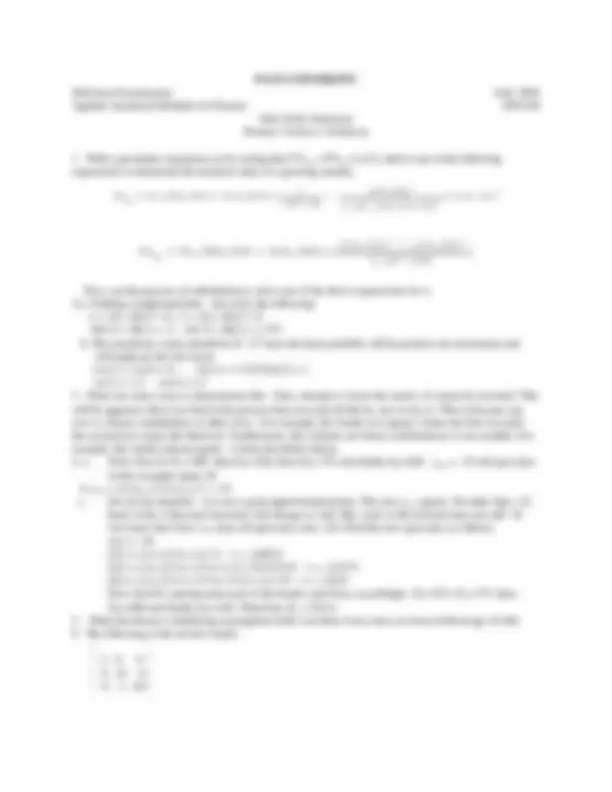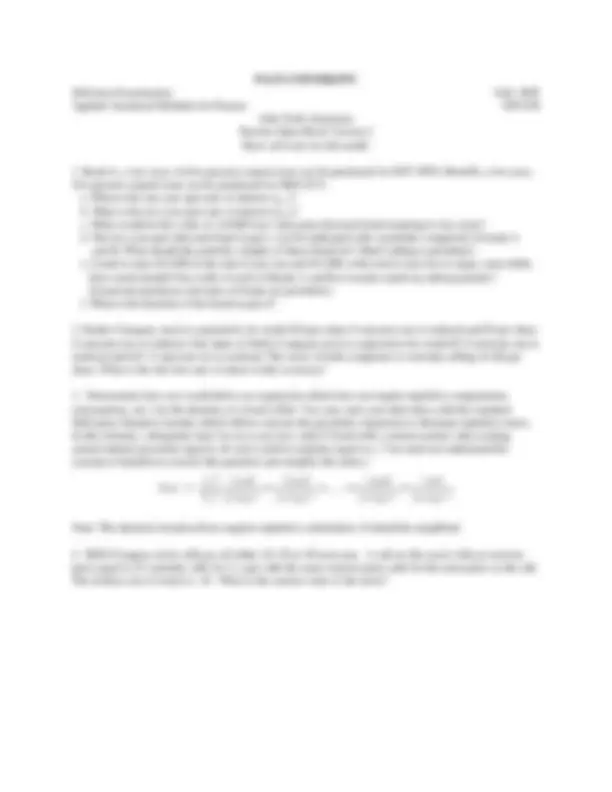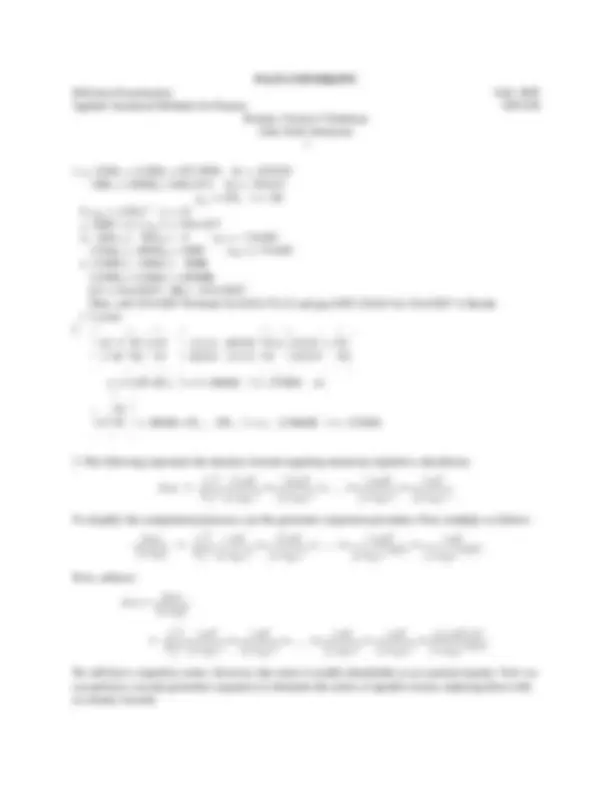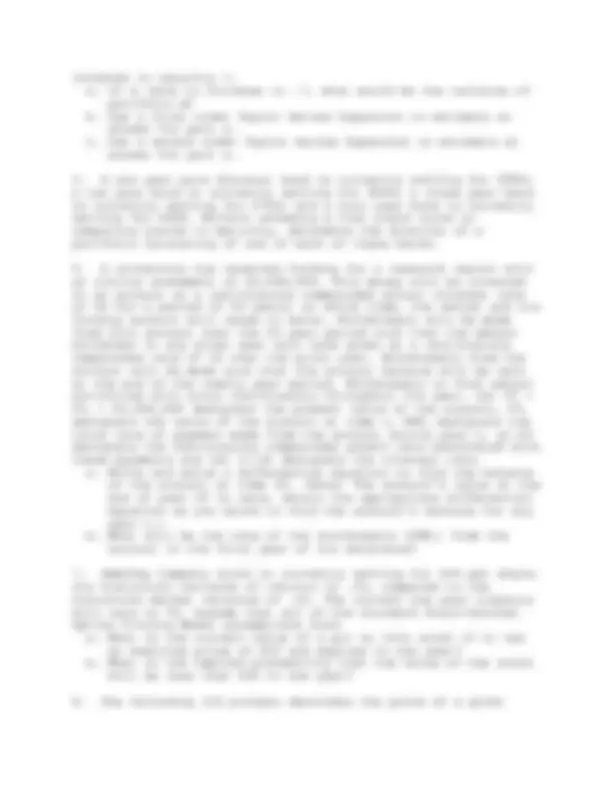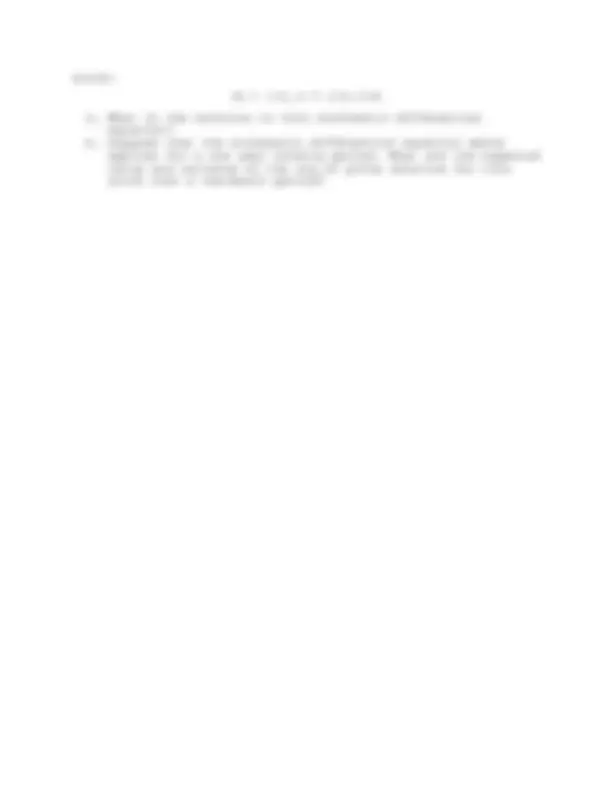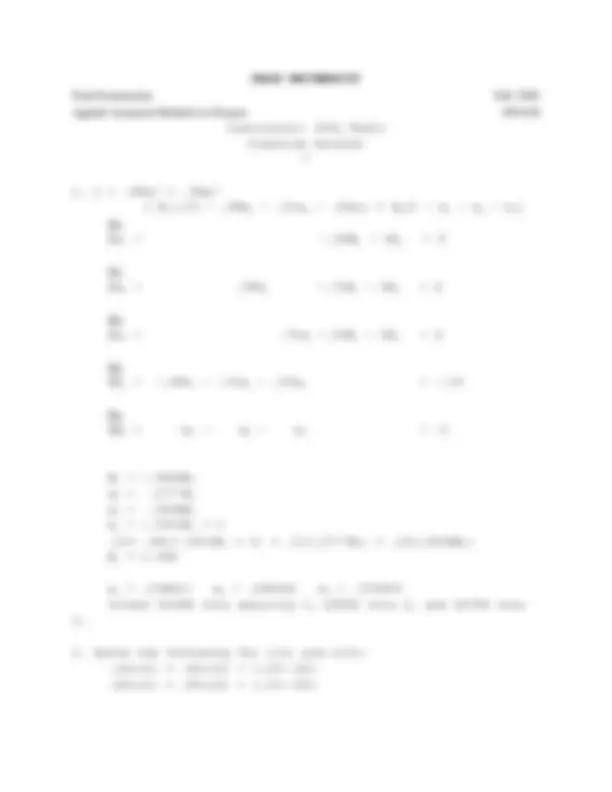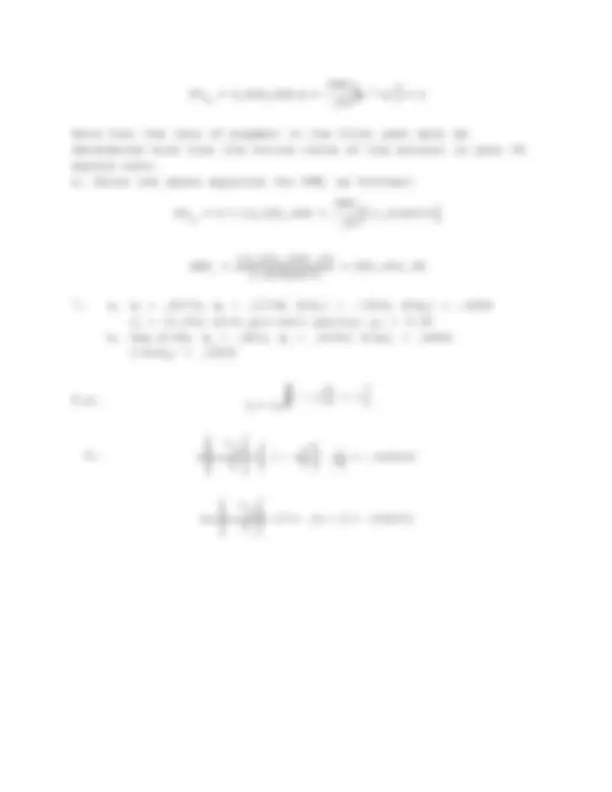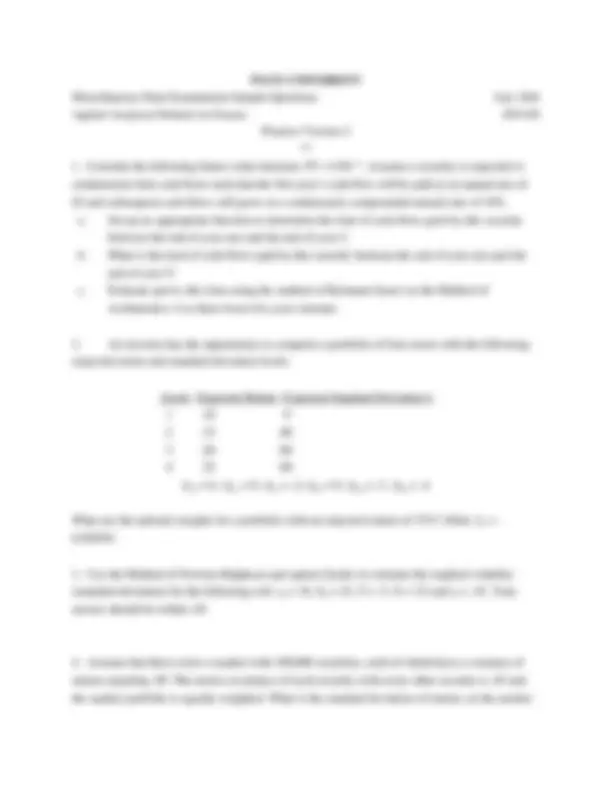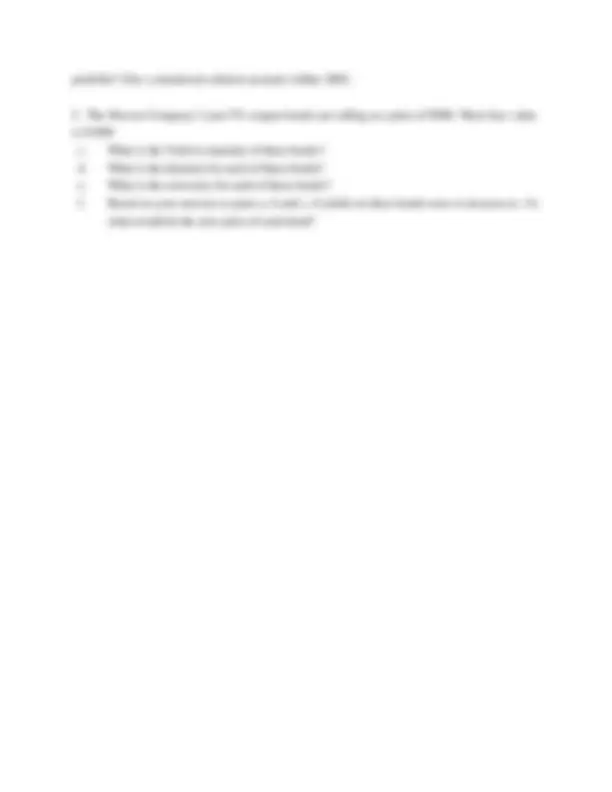Download Applied Analytical Methods in Finance - Midterm Examination | FIN 650 and more Exams Finance in PDF only on Docsity!
PACE UNIVERSITY Mid-term Examination Fall, 2005 Applied Analytical Methods for Finance FIN 650 John Teall, Instructor Practice Version 1 Show all work for full credit!
- I have decided that I will retire when I become a millionaire; that is, when my bank account has $1,000,000, I will retire. This year, I will make my first deposit of $10,000 into my bank account; next year I will deposit $11,000, the following year I will deposit $12,100, and so on. Thus, my deposit amount will be ten percent greater in each year than in the prior year. Furthermore, I will earn interest on my account at an annual rate of 12%. How many years must I continue to make deposits into my account before I can retire with my million dollars? Demonstrate how you would solve this problem without setting up a summation process based on finding cash flow present values one year at a time. That is, find an appropriate annuity function to perform your substitutions.
2.a. Two securities, A and B exist in an environment with a single risk factor. Assume that expected returns for Securities A and B are .1 and .2, respectively. The riskless return rate equals .04 and the expected value of the index equals .12. Based on these details, what are the security betas? b. Solve for weights for the basis portfolios for the risk factor. List weights for the two securities.
- Suppose that the columns in the following matrix represent payoffs of four securities in a four outcome space. Demonstrate that these four payoff vectors cannot span the four dimension state space. 5 0 0 0 5 6 0 0 9 10 5 - 6 -4 -5 2
- The following table reflects riskless bond prices, coupon rates and terms to maturity for an economy: COUPON TERM TO BOND PRICE RATE MATURITY A 1000 10% 1 yr. B 1000 10% 2 yrs. C 1000 10% 3 yrs. D 1000 10% 4 yrs. Assuming the bonds make annual coupon payments at year end, answer the following questions based on the above information: a. What is the four year spot rate? b. What is the two year forward rate for a loan originated one year from now? c. If the one year spot rate were to double, but none of the forward rates were to change, what would the new price be for Bond C? (Note: other spot rates may change also)
- Under what circumstances might state preference theory be used to value securities?
- Invert the following matrix:
. -
Dur '
P 0
R
F
& 1 cF (1% y )^1
& 2 cF (1% y )^2
& ncF (1% y ) n^
& nF (1% y ) n
X
L
PACE UNIVERSITY Mid-term Examination Fall, 2005 Applied Analytical Methods for Finance FIN 650 John Teall, Instructor Practice Open-Book Version 2 Show all work for full credit!
- Bond A, a two year, twelve percent coupon issue can be purchased for $957.9920. Bond B, a two year, five percent coupon issue can be purchased for $840.2471. a. What is the one year spot rate of interest (y0,1)? b. What is the two year spot rate of interest (y0,2)? c. What would be the value of a $1000 face value pure discount bond maturing in two years? d. The two year pure discount bond in part c can be replicated with a portfolio comprised of bonds A and B. What should the portfolio weights of these bonds be? (Short selling is permitted.) e. I need to raise $15,000 at the end of year one and $12,000 at the end of year two to repay some debts. How much should I buy (sell) of each of Bonds A and B to exactly match my debt payments? (Fractional purchases and sales of bonds are permitted.) f. What is the duration of the bond in part d?
- Keeler Company stock is expected to be worth $10 per share if outcome one is realized and $5 per share if outcome two is realized. One share of Duffy Company stock is expected to be worth $2 if outcome one is realized and $10 if outcome two is realized. The stock of both companies is currently selling for $6 per share. What is the risk-free rate of return in this economy?
- Demonstrate how you would derive an expression which does not require repetitive computations (summations, etc.) for the duration of a bond. (Hint: You may start your derivation with the standard MaCaulay Duration formula which follows and use the geometric expansion to eliminate repetitive terms. In this formula, t designates time for an n year face value F bond with a current market value making annual interest payments equal to cF and a yield to maturity equal to y. You need not understand the concept of duration to answer this question; just simplify the series.)
Note: The duration formula above requires repetitive calculations. It should be simplified.
- BOS Company stock will pay off either 10, 20 or 30 next year. A call on this stock with an exercise price equal to 25 currently sells for 2; a put with the same exercise price sells for the same price as the call. The riskless rate of return is .10. What is the current value of the stock?
PACE UNIVERSITY Mid-term Examination Fall, 2005 Applied Analytical Methods for Finance FIN 650 Practice Version 2 Solutions John Teall, Instructor
- a. 120D 1 + 1120D 2 = 957.9920 D 1 =. 50D 1 + 1050D 2 = 840.2471 D 2 =. y0,1 = 1/D 1 - 1 =. b. y0,2 = (1/D 2 ).5^ - 1 =. c. 1000 ÷ (1 + y0,2)^2 = 756. d. 120wA + 50wB = 0 wA = -. 1120wA + 1050wB = 1000 wB = 1. e. 15,000 = 120#A + 50#B 12,000 = 1120#A + 1050#B #A = 216.42857 ; #B = -219. Thus, sell 219.42857 B bonds for $184,374.22 and pay $207,336.83 for 216.42857 A Bonds f. 2 years
-
- 10 5 **P 1 *= * 6 * * .11111 -.05555 ** 6 *= *.33333 * = *P 1 *
- 2 10 **P 2 * * 6 * *-.02222 .11111 ** 6 * *.53333 * *P 2 * . -. -. -. -. -. -. - rf = 1÷(P 1 +P 2 ) - 1 = 1÷.86666 - 1 = .153846 or: + ,
- 11 **P 2 * = .86666 = Prf ; 1/Prf - 1 = rf ; 1/.86666 - 1 =. . -. -
- The following represents the duration formula requiring numerous repetitive calculations:
Dur '
P 0
R
F
& 1 cF (1% y )^1
& 2 cF (1% y )^2
& ncF (1% y ) n^
& nF (1% y ) n
X
L
To simplify the computational process, use the geometric expansion procedure. First, multiply as follows:
Dur (1% y )
P 0
R
F
& cF (1% y )^2
% &^2 cF (1% y )^3
%...% & ncF (1% y )( n %1)^
% & nF (1% y )( n %1)
X
L
Next, subtract:
Dur & Dur (1% y )
P 0
R
F
& cF (1% y )^1
& cF (1% y )^2
& cF (1% y ) n^
& nF (1% y ) n^
n ( c %1) F (1% y )( n %1)
X
L
We still have a repetitive series. However, this series is readily identifiable as an n-period annuity. Now we can perform a second geometric expansion to eliminate this series of repetitive terms, replacing them with an annuity formula:
PACE UNIVERSITY
Final Examination Fall, 2005 Applied Analytical Methods for Finance FIN 650 Practice Version, Open Book
- An investor needs to invest $10,000 into a portfolio of three securities which enables him to minimize risk while maintaining an expected return of at least 15%. The following table represents the expected returns, standard deviations and covariances for the securities:
i E[Ri] ói ói,j 1 .06 0 ó1,2= 2 .11 .3 ó1,3= 3 .25 .6 ó2,3=
How much money should the investor put into each of the stocks?
- An investor has the opportunity to invest in any combination of the securities given in the table below:
SECURITY(i) E[R] ó(i) COV(i,1) COV(i,2) COV(i,3) 1 .25 .40 .16 .05 0 2 .15 .20 .05 .04 0 3 .05 0 0 0 0
Find the expected return and variance of the market portfolio in addition to the slope of the Capital Market Line.
- A particular market consists of three securities: a riskless asset paying 10%, shares of common stock and calls written on these shares with an exercise price of 8. This market exists in a one time period framework with three potential outcomes. The stock, which is currently selling for 10 will either decrease to 5 next year, remain unchanged at 10 or increase to 15. Outcome probabilities are unknown. In this market, can a "trinomial" option pricing model based on construction of hedge portfolios be derived to value this option? If so, how? If not, why not?
- Suppose an investor holds a portfolio m with two securities, 1 and 2 such that the following holds:
E[R 1 ] = .12 ó 1 =. E[R 2 ] = .18 ó 2 =. ó1,2 = -.
This portfolio has weights w 1 = .627 and w 2 = .373 such that E[Rm] = .142 and ó^2 m = .0333. Remember that w 2 = 1-w 1. This problem will be concerned with the sensitivity of ó^2 m to the proportion
invested in security 1. a. If w 1 were to increase to .7, what would be the variance of portfolio m? b. Use a first order Taylor Series Expansion to estimate an answer for part a. c. Use a second order Taylor Series Expansion to estimate an answer for part a.
- A one year pure discount bond is currently selling for $900; a two year bond is currently selling for $800; a three year bond is currently selling for $700; and a four year bond is currently selling for $600. Without assuming a flat yield curve or computing yields to maturity, determine the duration of a portfolio consisting of one of each of these bonds.
- A university has received funding for a research center with an initial endowment of $5,000,000. This money will be invested in an account at a continuously compounded annual interest rate of 5% for a period of 20 years, at which time, the center and its funding account will cease to exist. Withdrawals will be made from this account over the 20 year period such that the amount withdrawn in any given year will have grown at a continuously compounded rate of 2% over the prior year. Withdrawals from the account will be made such that the account balance will be zero at the end of the twenty year period. Withdrawals to fund center activities will occur continuously throughout the year. Let PV = FV 0 = $5,000,000 designate the present value of the account, FVt designate the value of the account at time t, PMTt designate the total rate of payment made from the account during year t, g=. designate the continuously compounded growth rate associated with these payments and let i=.05 designate the interest rate. a. Write and solve a differential equation to find the balance of the account at time 20. (Note: The account’s value at the end of year 20 is zero; obtain the appropriate differential equation as you would to find the account’s balance for any year t.) b. What will be the rate of the withdrawals (PMT 1 ) from the account in the first year of its existence?
- Smedley Company stock is currently selling for $40 per share. Its historical variance of returns is .25, compared to the historical market variance of .10. The current one year treasury bill rate is 5%. Assume that all of the standard Black-Scholes Option Pricing Model assumptions hold. a. What is the current value of a put on this stock if it has an exercise price of $35 and expires in one year? b. What is the implied probability that the value of the stock will be less than $30 in one year?
- The following Itô process describes the price of a given
PACE UNIVERSITY
Final Examination Fall, 2005
Applied Analytical Methods for Finance FIN 650
Instructor: John Teall Practice version
- L = .09w 22 + .36w 32
- ë 1 (.15 - .06w 1 - .11w 2 - .25w 3 ) + ë 2 (1 - w 1 - w 2 - w 3 ) äL äw 1 = -.06ë 1 - 1ë 2 = 0
äL äw 2 = .18w 2 -.11ë 1 - 1ë 2 = 0
äL äw 3 = .72w 3 -.25ë 1 - 1ë 2 = 0
äL äë 1 = -.06w 1 - .11w 2 - .25w 3 = -.
äL äë 2 = -w 1 - w 2 - w 3 = -
ë 2 = -.0600ë 1 w 2 = .2777ë 1 w 3 = .2638ë 1 w 1 = -.5415ë 1 + 1 .15= .06(-.5415ë 1 + 1) + .11(.2777ë 1 ) + .25(.2638ë 1 ) ë 1 = 1.
w 1 = .238611 w 2 = .390455 w 3 =. Invest $2386 into security 1, $3905 into 2, and $3709 into
Solve the following for z(1) and z(2):
.16z(1) + .05z(2) = (.25-.05) .05z(1) + .04z(2) = (.15-.05)
ó^2 p ' .04 w (^) 12 % .16 % .16 w (^) 12 & .32 w 1 & .02 w 1 % .02 w (^) 12
ó^2 p ' .04@.7^2 % .16 % .16@.7^2 & .32@.7 & .02@.7 % .02@.7^2 '.
d ó^2 m dw 1
' .08 w 1 % .32 w 1 & .32 & .02 % .04 w 1 ' .44 w 1 &.34 ' &.
d^2 ó^2 m
dw (^) 12
z(1) = .7692308 ; z(2) = 1. Thus, w(1) = .333333333 and w(2) =. E[R(m)] = .21666667 , ó^2 m = .09777778; È = 1.
- A "trinomial" option pricing model cannot be derived because
a hedge portfolio cannot be constructed in a one time period,
three potential outcome scenario. That is, no value for á
satisfies:
áuP 0 - cu = áP 0 - cno change = ádP 0 - cd á15 - 7 = á10 - 2 = á5 - 0
- a. First, because w 2 = 1-w 1 , we write portfolio variance as
follows:
When w 1 = .7, this is written as follows:
b. Find the derivative of ó^2 m with respect to w 1 , which
equals -.06412 when w 1 =.627:
Thus, since the change in w 1 = .073, the revised ó^2 m = .0333 -
(.06412 @ .073) =.
c. Find the second derivative of ó^2 m with respect to w 1 ,
which equals .44 when w 1 =.627:
Thus, since the change in w 1 = .073, the revised ó^2 m = .0333 -
(.06412 @ .073) + .5@.44@.073^2 =.
- [(900@1)+(800@2)+(700@3)+(600@4)]/3000 = 2.33333 years
6.a. This differential equation can be constructed from two
parts. First, the account should generate interest each period as
follows:
FV 20 ' 5,000,000@ e %
PMT 1
e .4& e^1 ' 0
Note that the rate of payment in the first year must be
determined such that the future value of the account in year 20
equals zero.
b. Solve the above equation for PMT 1 as follows:
FV 20 ' 0 ' 13,591,409 %
PMT 1
PMT 1 '
- a. d 1 = .6172; d 2 = .1178; N(d 1 ) = .7314; N(d 2 ) =.
c 0 = 11.05; with put-call parity: p 0 = 4. b. Use X=30; d 1 = .925; d 2 = .4245; N(d 2 ) =. 1-N(d 2 ) =.
8.a. (^) S T '^ S 0 e^
.1 & .5 22 T % .5 Zt
b. (^) E ln
S (^) 1 12 S 0
' .1 &.
2 2
@ 1 12
' &.
Var ln
S (^) 1 12 S 0
' ó^2 T ' .25 ÷ 12 '.
PACE UNIVERSITY
Miscellaneous Final Examination Sample Questions Fall, 2005
Applied Analytical Methods for Finance FIN 650
Practice Version 2 **
- Consider the following future value function: FV = CFe.1@t. Assume a security is expected to
continuously leak cash flows such that the first year’s cash flow will be paid at an annual rate of
$2 and subsequent cash flows will grow at a continuously compounded annual rate of 10%.
a. Set up an appropriate function to determine the total of cash flows paid by this security between the end of year one and the end of year 5. b. What is the total of cash flows paid by this security between the end of year one and the end of year 5? c. Estimate part b, this time using the method of Reimann Sums (or the Method of Archimedes). Use three boxes for your estimate.
- An investor has the opportunity to comprise a portfolio of four assets with the following
expected return and standard deviation levels:
Assets Expected Return Expected Standard Deviation ó 1 .10 0 2 .15. 3 .20. 4 .25. ñ 12 = 0 ; ñ 13 = 0 ; ñ 23 = .2; ñ 14 = 0 ; ñ 24 = .3 ; ñ 34 =.
What are the optimal weights for a portfolio with an expected return of 15%? (Hint: ë 1 = -
0.85059)
- Use the Method of Newton-Ralphson and option Greeks to estimate the implied volatility
(standard deviation) for the following call: c 0 = 10, S 0 = 25, T = .5, X = 35 and rf = .10. Your
answer should be within .03.
- Assume that there exists a market with 100,000 securities, each of which have a variance of
returns equaling .09. The return covariance of each security with every other security is .03 and
the market portfolio is equally weighted. What is the standard deviation of returns on the market
PACE UNIVERSITY
Sample Final Examination Question Solutions Fall, 2005
Applied Analytical Methods for Finance Instructor: John Teall
Practice version 2 **
1.a. FV = I^51 2e.1@tdt
b. FV = I^51 2e.1@tdt = 20e.1@t ^51 = 32.97 - 22.10 = 10. c. FV = (1.333331.2628) + (1.333331.4429) + (1.333331.6487) = 5.
- L = .16w^22 + .64w^23 + .81w^24 + .128w 2 w 3 + .216w 2 w 4 + .576w 3 w 4 + ë 1 (.15-.1w 1 -.15w 2 -.2w 3 -
.25w 4 ) + ë 2 (1-w 1 -w 2 -w 3 -w 4 )
ML/Mw 1 = -.1ë 1 - 1ë 2 = 0 ML/Mw 2 = .32w 2 + .128w 3 + .216w 4 -.15ë 1 - 1ë 2 = 0 ML/Mw 3 = .128w 2 + 1.28w 3 + .576w 4 -.2ë 1 - 1ë 2 = 0 ML/Mw 4 = .216w 2 + .576w 3 + 1.62w 4 -.25ë 1 - 1ë 2 = 0 ML/Më 1 = .10w 1 + .15w 2 + .20w 3 + .25w 4 =. ML/Më 2 = 1w 1 + 1w 2 + 1w 3 + 1w 4 = 1
w 1 = 0.246607; w 2 = 0.574323; w 3 = 0.111533; w 4 = 0.
ë 1 = -0.85059; ë 2 = -0.
- Try an initial guess for standard deviation equal to .5. This results in a call value equal to 1.93.
Based on an estimate for vega, our next estimate for standard deviation would be .5-(1.93-5)/(
- (.5^0.5) * (e^(-(-.633^2)/2))/(6.28^0.5)) = 1.15. The next and final estimate for standard
deviation would be 1.067.
- Since market portfolio consists of 100,000 securities with ói,j = .03, the sum of the squared
weighted variances equals approximately zero. Therefore, the market portfolio variance equals the
average security covariance, which equals .03. Thus, the market standard deviation (óp) equals
.1732.
- a. ytm = .08946803 , or approximately .09 used below. If your answer is anywhere between
.07946803 and .09946803, it is acceptable. b. Dur = [-(50/1.09) - (100/1.09^2) - (3150/1.09^3)]/ Dur = -2.8512078 years
c. Con = [(1+1)50/(1.09)^3 + (2+4)50/(1.09)^4 + (3+9)*1050/(1.09)^5]/900 = 9.
d. New Price = 900 - 2.85(.14-.0894)1000/(1+.0894) + .59009.4438*(.14-.0894)^2 =
791.

